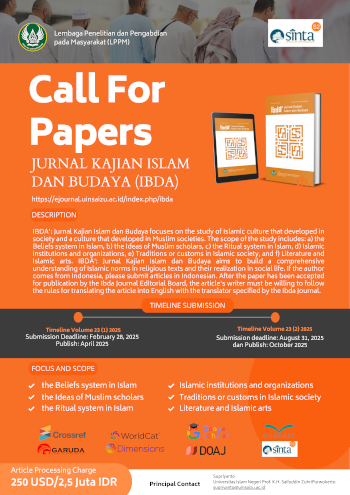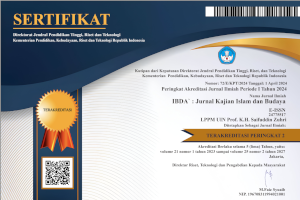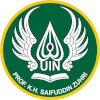Local Culture in the Dynamics of Islamic Religious Organizations (Study on Muhammadiyah Branch of Padang Lawas Utara District)
DOI:
https://doi.org/10.24090/ibda.v22i2.12230Keywords:
Dynamics, Development, MuhammadiyahAbstract
Muhammadiyah is one of Indonesia's most prominent Islamic religious organizations, growing rapidly as a leading religious organization in health and education. This research examines the challenges faced by the Muhammadiyah branch in the Padang Lawas Utara district. This study explores the dynamics between Muhammadiyah's institutional practices and the cultural frameworks within which they operate. The study utilizes a case study method to provide an in-depth understanding of the interactions between Muhammadiyah's organizational practices and local cultural elements. Data collection involves semi-structured interviews with key informants, participant observation, and document analysis of relevant organizational records and cultural artifacts. Data analysis was conducted using thematic analysis. A triangulation method is employed to ensure the validity and reliability of the data. The findings indicate that while local traditions can enhance the acceptance of Muhammadiyah's reformist ideals, they can also present challenges when cultural norms conflict with the organization's objectives. They are reluctant to accept the Muhammadiyah ideology due to the incompatibility between local culture and Islamic teachings.Downloads
References
Ahmad, M. (2019). The Role of Muhammadiyah in Sustainable Development Through Community Empowerment Program. IOP Conference Series: Earth and Environmental Science, 356(1). https://doi.org/10.1088/1755-1315/356/1/012002
Aji, G. S. (2019). Pengembangan Kurikulum Program Unggulan di SD Muhammadiyah Kleco Kotagede. Jurnal Pendidikan Agama Islam, 16(1), 63–74. https://doi.org/10.14421/jpai.2019.161-04
Benedetti, C. (2021). Showing themselves: Indigenous people, cultural heritage promotion and community development in Northern Argentina. International Journal of Heritage Studies, 27(10), 1025–1037. https://doi.org/10.1080/13527258.2021.1922932
Budi, D. R., Widyaningsih, R., Nur, L., Agustan, B., Dwi, D. R. S., Qohhar, W., & Asnaldi, A. (2021). Cycling during covid-19 pandemic: Sports or lifestyle? International Journal of Human Movement and Sports Sciences, 9(4), 765–771. https://doi.org/10.13189/saj.2021.090422
Dasopang, M. D. (2022). Integration of Religion and Culture in Muslim Minority Communities Through Islamic Education. Jurnal Pendidikan Islam, 8(2), 221–238. https://doi.org/10.15575/jpi.v8i2.19445
Elfia. (2022). The Productivity of West Sumatra Muhammadiyah Cash Waqf as a Model for the Development of Sharia Investment in Empowering UMKM. Jurnal Ilmiah Al-Syir’ah, 20(2), 167–189. https://doi.org/10.30984/jis.v20i2.2053
Haji Yahya Zikri, S., Ismail, K., Hashim, N., & Ahmad, A. (2023). Islam in the Malay History and Culture: Its Impacts on the Malay Culture, Language & Literature. International Journal of Modern Education, 5(17), 244–256. https://doi.org/10.35631/ijmoe.517020
Hamami, T. (2021). Muhammadiyah and Nahdlatul Ulama Education: Two Main Pillars of National Education in Indonesia. Jurnal Pendidikan Agama Islam, 18(2), 307–330. https://doi.org/10.14421/jpai.2021.182-06
Khoirudin, A. (2020). Exploring muhammadiyah’s historical civilizational dimension of social reconstruction in Indonesia: Humanitarian and cosmopolitan approaches. Journal of Al-Tamaddun, 15(1), 183–197. https://doi.org/10.22452/JAT.vol15no1.13
Kurniawati, L., & Junaidi, J. (2024). The Role of Muhammadiyah in Education in Indonesia. JUPE: Jurnal Pendidikan …, 9(2), 480–484. https://ejournal.mandalanursa.org/index.php/JUPE/article/view/7054%0Ahttps://ejournal.mandalanursa.org/index.php/JUPE/article/download/7054/4993
Mursyid, F. K. (2023). The History of Muhammadiyah. Journal of Indonesian History, 11(1), 27–32. https://doi.org/10.15294/jih.v11i1.63236
Nashir, H., Qodir, Z., Nurmandi, A., Jubba, H., & Hidayati, M. (2019). Muhammadiyah’s Moderation Stance in the 2019 General Election. Al-Jami’ah, 57(1), 1–24. https://doi.org/10.14421/ajis.2019.571.1-24
Nasution, H., & Samosir, H. E. (2019). Pemberdayaan Filantropi Dalam Meningkatkan Kesejahteraan Warga Muhammadiyah di Indonesia. Miqot, 43(2), 278–299.
Pohl, F. (2012). The Muhammadiyah: A Muslim Modernist Organization in Contemporary Indonesia. The Wiley-Blackwell Companion to Religion and Social Justice, 241–255. https://doi.org/10.1002/9781444355390.ch15
Qodir, Z. (2018). Kaum Muda, Intoleransi, dan Radikalisme Agama. Jurnal Studi Pemuda, 5(1), 429. https://doi.org/10.22146/studipemudaugm.37127
Rantau Ismail. (2023). Cultural Harmonization in the Midst of Modernity: A Sociological Study of the Mappacci Tradition in Bugis Weddings in Purun Village, Penukal District, Penukal Abab Lematang Ilir Regency (PALI) South Sumatra. QURU’: Journal of Family Law and Culture, 1(3), 316–337. https://doi.org/10.59698/quru.v1i3.110
Saidang, S. P. M. (2024). Dialectics Of Muhammadiyah Organization: Social Challenges And Adaptation In Local Culture. Proceedings Series on Proceedings of …, 2(2). https://journal.conference.umpalopo.ac.id/index.php/icbens/article/view/36%0Ahttps://journal.conference.umpalopo.ac.id/index.php/icbens/article/download/36/37
Susilo, M. J. (2019). Figure of community support in achieving muhammadiyah school autonomy progress. International Journal of Evaluation and Research in Education, 8(1), 20–28. https://doi.org/10.11591/ijere.v8i1.15093
Warter, L. (2019). The Impact of Organizational Culture in Higher Education. Case Study. Journal of Intercultural Management and Ethics, 2(2), 173–200. https://doi.org/10.35478/jime.2019.2.15
Wekke, I. S. (2019). The Role Of Muhammadiyah Institution Towards Muslim Minority In West Papua. Jurnal Ilmiah Peuradeun, 7(1), 21–42. https://doi.org/10.26811/peuradeun.v7i1.311
Weli Tridayatna AS, Fathiyah Shabrina Mudafri, I. S. K. (2024). Sejarah dan peran muhammadiyah di dalam pendidikan. Proceeding International Seminar On Islamic Studies, 5(1), 1323–1329.
Downloads
Published
How to Cite
Issue
Section
License
Copyright (c) 2024 Dedy Suhendra, Mulyadi Hermanto, Sutan Siregar, Abdul Azis Abidan

This work is licensed under a Creative Commons Attribution-ShareAlike 4.0 International License.
Authors who publish with this journal agree to the following terms:
- Authors retain copyright and grant the journal right of first publication with the work simultaneously licensed under a Creative Commons Attribution-ShareAlike License a that allows others to share the work with an acknowledgement of the work's authorship and initial publication in this journal.
- Authors are able to enter into separate, additional contractual arrangements for the non-exclusive distribution of the journal's published version of the work (e.g., post it to an institutional repository or publish it in a book), with an acknowledgment of its initial publication in this journal.
- Authors are permitted and encouraged to post their work online (e.g., in institutional repositories or on their website) before and during the submission process, as it can lead to productive exchanges, as well as earlier and greater citation of published work (See The Effect of Open Access).
















